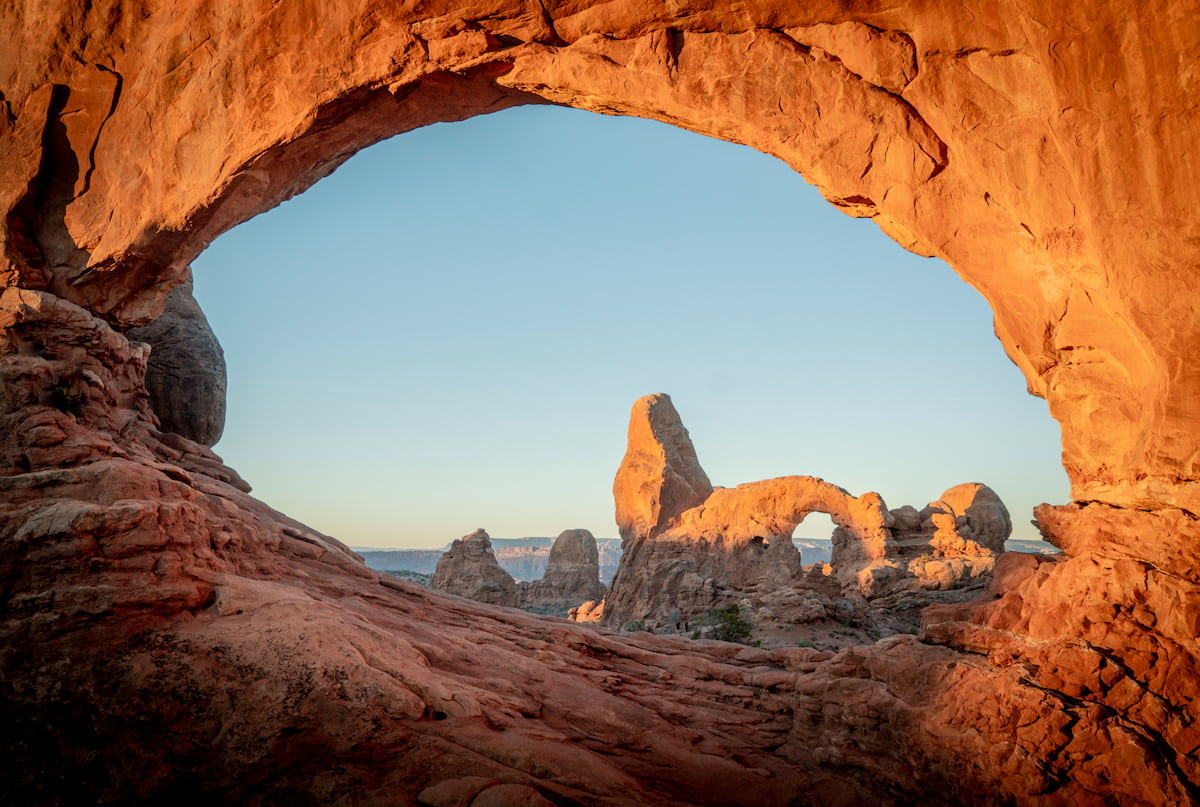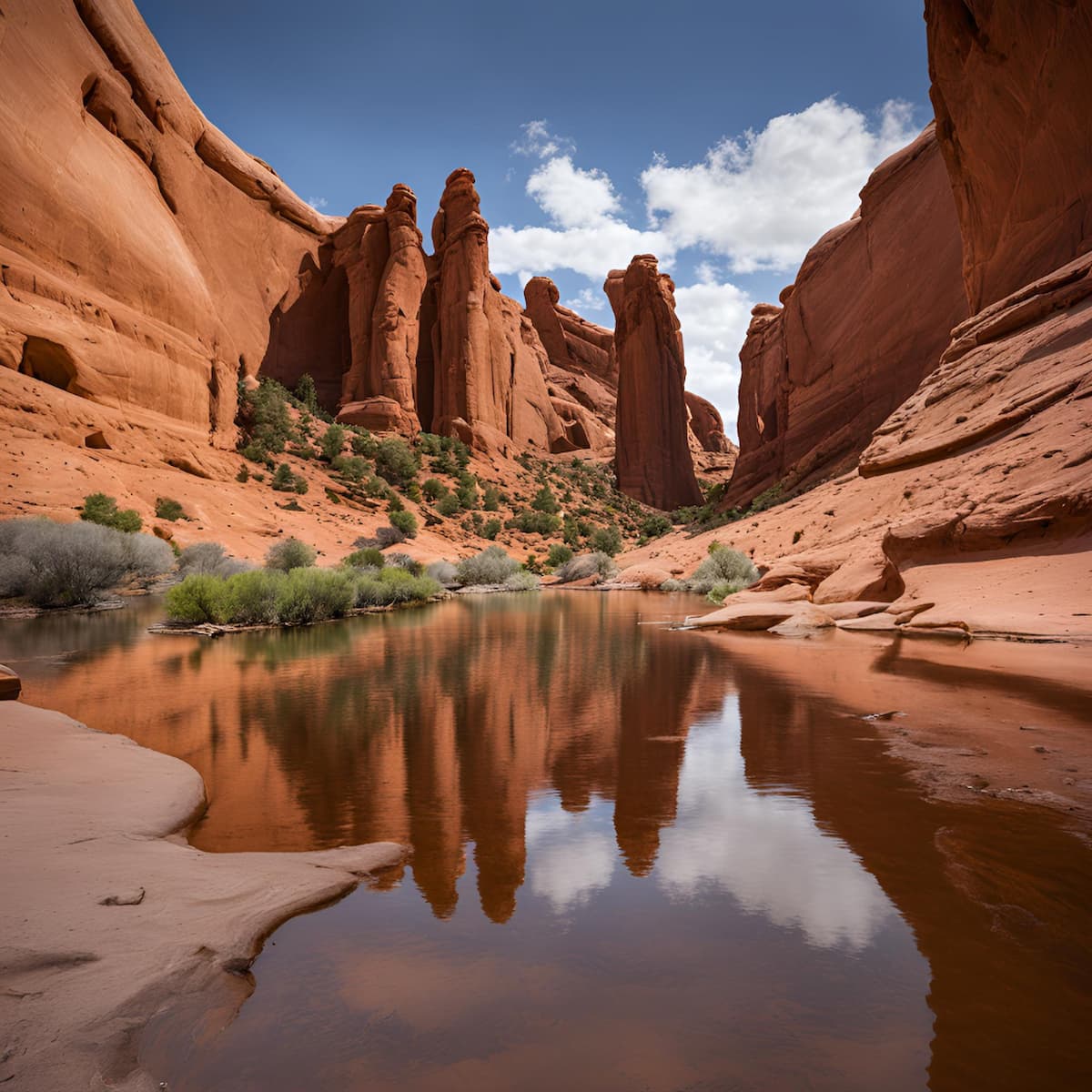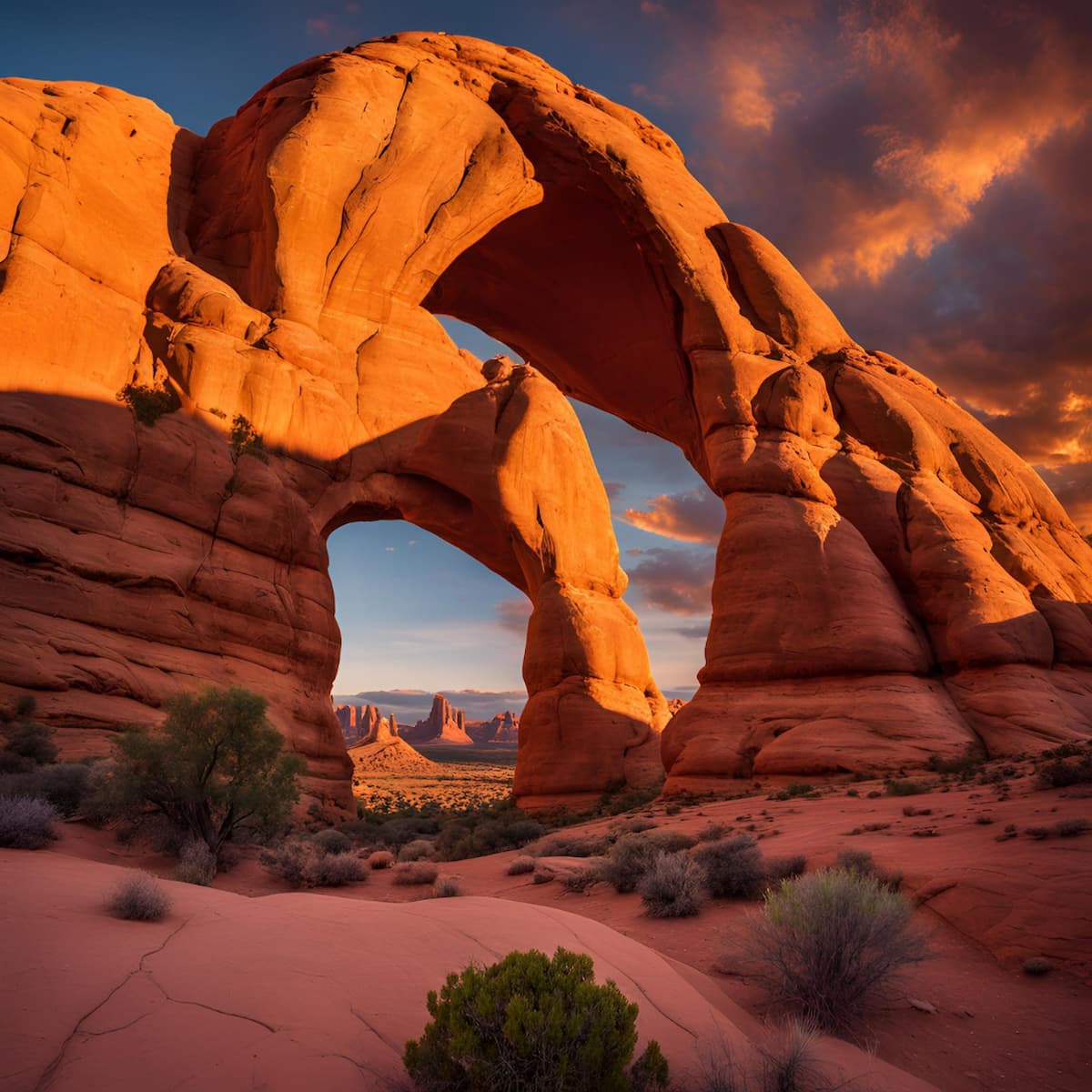
Watch short for this article (5 slides)
Arches National Park: Sculpted by Time, Wind, and Water in Utah's High Desert
In the arid landscape of southeastern Utah lies Arches National Park, a geological masterpiece renowned worldwide for its extraordinary concentration of natural sandstone arches – over 2,000 documented spans within its boundaries. This high desert park, covering more than 76,000 acres, showcases a surreal collection of colossal fins, balanced rocks, soaring pinnacles, and, most famously, the delicate, improbable stone bridges sculpted by millions of years of erosion. The striking red rock formations, set against the backdrop of the La Sal Mountains and vast desert skies, create a landscape of profound beauty and geological fascination, drawing millions to explore its unique wonders.

Photo by Intricate Explorer on Unsplash - Delicate Arch is a world-renowned symbol of Arches National Park and Utah.
The Recipe for Arches: A Deep Dive into Geology
The seemingly magical landscape of Arches is the result of specific geological ingredients and processes acting over immense timescales:
- Deposition of Sediments: Hundreds of millions of years ago (primarily during the Jurassic period, ~150 million years ago), this region experienced varied environments, from vast deserts with towering sand dunes to coastal plains and shallow seas. Layers upon layers of sediment – sand, silt, mud – were deposited and eventually lithified (turned into rock). Key layers include the reddish-orange Entrada Sandstone (where most arches form) sitting atop the paler Navajo Sandstone.
- The Paradox Formation Salt Layer: Beneath these sandstone layers lies a crucial, much older layer (from the Pennsylvanian period, ~300 million years ago) called the Paradox Formation. This layer contains thick deposits of salt left behind by ancient evaporating seas. Salt behaves like a viscous fluid under immense pressure. As overlying rock layers accumulated, the weight caused the less dense salt layer to buckle, flow, and push upwards, creating subsurface domes and anticlines (upward folds) in the rock strata above. This movement also created extensive systems of parallel vertical cracks, or joints, in the brittle sandstone layers.
- Uplift of the Colorado Plateau: Regional tectonic forces gradually uplifted the entire Colorado Plateau, including the Arches area, starting around 65 million years ago. This uplift increased the erosive power of water and exposed the rock layers to surface weathering.
- Erosion and Weathering – The Sculpting Process: This is where the magic happens. Water is the primary sculptor, exploiting the joints created by the salt tectonics:
- Chemical Weathering: Rainwater, slightly acidic, seeps into the joints and slowly dissolves the calcite cement holding the sandstone grains together.
- Physical Weathering:
- Frost Wedging: Water freezes in the cracks, expands (by about 9%), and pries the rock apart. The region's significant daily temperature swings above and below freezing during cooler months make this highly effective.
- Wind Abrasion: Wind carrying sand particles sandblasts rock surfaces, particularly effective at widening existing openings.
- Water Runoff: Rain carries away loosened material and scours channels.
- From Joints to Fins to Arches: This relentless weathering attacks the vertical joints, widening them into slots. As erosion progresses, material between parallel joints is removed, leaving behind relatively narrow, wall-like rock formations called fins. Continued weathering attacks weaker sections within these fins, eventually creating openings. Wind and water enlarge these openings, sculpting them into the diverse arches we see today. The process is ongoing; arches continue to form, enlarge, and eventually collapse (like the Wall Arch collapse in 2008). (Source: NPS - Arches Geologic Formations)

Arches form through a multi-stage process involving uplift, faulting, and differential erosion of sandstone fins.
A Gallery of Stone Masterpieces: Iconic Formations
While over 2,000 arches exist, several stand out for their size, form, or iconic status:
- Delicate Arch: The undisputed symbol of the park (and featured on Utah license plates). This freestanding arch, carved from Entrada Sandstone, stands majestically in a natural sandstone bowl, offering breathtaking views, especially at sunset. Reaching it requires a moderately strenuous 3-mile (4.8 km) roundtrip hike with significant elevation gain and little shade – demanding preparation, especially in summer heat.
- Landscape Arch: Located in the Devils Garden area, Landscape Arch boasts the longest natural stone span in North America (and one of the longest globally), measuring approximately 290 feet (88 meters) base to base. Its incredibly thin and delicate structure underscores the ongoing process of erosion; a large slab fell from its underside in 1991, prompting trail closure beneath it. Access is via a relatively easy, mostly flat 1.6-mile (2.6 km) roundtrip trail.
- Double Arch: Situated in the Windows Section, this impressive feature consists of two massive arches sharing the same stone foundation, soaring high above the ground. It was formed differently from most arches, primarily by water erosion from above (pothole erosion) rather than side-to-side weathering of a fin. Easily accessible via a short, flat trail (0.5 miles / 0.8 km roundtrip).
- The Windows Section (North Window, South Window, Turret Arch): A concentrated area featuring large, easily accessible "window" arches offering picturesque views. Short, easy trails connect these features, making it a very popular area.
- Balanced Rock: A large boulder perched precariously atop a slender, eroding pedestal of mudstone. Accessible via a short loop trail (0.3 miles / 0.5 km).
- Park Avenue: An introductory viewpoint and short trail near the park entrance showcasing towering, sheer sandstone fins reminiscent of a city skyline.
- Fiery Furnace: Not a single arch, but a labyrinthine area of narrow sandstone canyons, fins, and hidden arches. Exploring this area requires navigational skill and physical agility; access is restricted to ranger-led tours (reservations required far in advance) or self-guided permits obtained after demonstrating competency.

Formations like the Three Gossips exemplify the towering fins characteristic of the park.
Exploring the Park: Hiking and Activities
Arches offers numerous ways to experience its unique landscape:
- Scenic Driving: The main park road (about 18 miles one way from the entrance to Devils Garden) provides access to major viewpoints and trailheads. Side roads lead to the Windows Section and Delicate Arch viewpoint areas.
- Hiking: The best way to appreciate the scale and detail of the formations. Trails vary widely:
- Easy: Balanced Rock Loop, Windows Loop, Double Arch Trail, Park Avenue Trail (viewpoint end), Landscape Arch Trail.
- Moderate: Delicate Arch Trail (strenuous due to elevation/exposure), Devils Garden Trail (to Double O Arch - involves scrambling), Tower Arch Trail.
- Strenuous: Fiery Furnace (requires permit/tour), Primitive Loop section of Devils Garden Trail (significant scrambling, exposure, route finding).
- Photography: The park is a photographer's dream, especially during the "golden hours" of sunrise and sunset when the low-angle light illuminates the red rock and creates dramatic shadows. Night photography is also popular due to dark skies.
- Stargazing: Designated as an International Dark Sky Park in 2019, Arches offers exceptional opportunities for viewing stars, planets, and the Milky Way, far from significant city light pollution. Ranger programs often focus on astronomy. (Source: DarkSky International - Arches)
- Ranger Programs: Guided walks and evening programs offered seasonally provide insights into the park's geology, ecology, and history.
- Canyoneering/Rock Climbing: Limited technical canyoneering and rock climbing routes exist but require significant expertise, permits, and adherence to strict regulations to protect fragile resources.
Important Note: The park implemented a timed entry reservation system during peak season (typically April through October) in recent years to manage congestion. Visitors should check the official park website for current requirements before planning a trip. (Source: NPS - Arches Timed Entry)
Life in the Arid Landscape: Flora and Fauna
Despite the harsh desert environment (hot summers, cold winters, low precipitation), Arches supports a surprising diversity of life adapted to survive:
- Plant Adaptations: Dominant plants include drought-tolerant species like Utah juniper, pinyon pine, Mormon tea, blackbrush, various cacti (prickly pear, claret cup), yuccas, and resilient grasses. Many plants have small leaves, waxy coatings, or extensive root systems to conserve water. Ephemeral wildflowers bloom briefly but spectacularly after sufficient rainfall, primarily in spring.
- Biological Soil Crust (Crucial & Fragile): Much of the sandy soil surface is covered by a dark, bumpy layer called biological soil crust (or cryptobiotic soil). This living community of cyanobacteria, lichens, mosses, algae, and microfungi is vital to the desert ecosystem. It stabilizes soil, prevents erosion, absorbs precious moisture, and fixes atmospheric nitrogen, enriching the soil for plants. This crust is extremely fragile and easily destroyed by footsteps or vehicle tires; recovery can take decades or centuries. Staying on marked trails is absolutely essential to protect it. (Source: NPS - Biological Soil Crust)
- Animal Adaptations: Most animals are adapted to conserve water and avoid midday heat. Many are nocturnal or crepuscular (active at dawn/dusk). Examples include:
- Mammals: Desert bighorn sheep (occasionally seen on rocky slopes), mule deer, kit foxes, kangaroo rats (get water metabolically from seeds), cottontail rabbits, bats.
- Reptiles: Various lizards (like the collared lizard) and snakes utilize thermoregulation (basking, seeking shade).
- Birds: Species adapted to arid conditions like rock wrens, canyon wrens, pinyon jays, white-throated swifts, plus raptors like peregrine falcons and Cooper's hawks.

Fragile biological soil crust is vital to the desert ecosystem; always stay on trails.
Protecting a Delicate Masterpiece: Conservation Challenges
Preserving the unique geology and fragile ecosystem of Arches requires careful management:
- Visitor Impact Management: High visitation leads to trail erosion, soil compaction, crowding, demand on facilities, and potential impacts on wildlife. Timed entry systems, shuttle buses (when operational), and extensive trail maintenance aim to mitigate these pressures.
- Resource Protection: Preventing graffiti and vandalism on rock formations, protecting fragile biological soil crust, managing noise pollution, and safeguarding archaeological sites are ongoing priorities.
- Climate Change: Potential impacts include increased temperatures exacerbating drought stress, altered precipitation patterns affecting erosion rates and vegetation, and potential changes in freeze-thaw cycles impacting arch stability.
- Invasive Plant Species: Non-native plants like cheatgrass and tamarisk can outcompete native species and alter fire regimes.
- Air Quality and Dark Skies: Monitoring and mitigating regional haze that impacts views and protecting the park's exceptional natural darkness are important goals.
Conclusion: A Window into Deep Time
Arches National Park offers an extraordinary journey through geological time, showcasing the slow, patient artistry of natural erosion on a grand scale. Its iconic arches, towering fins, and balanced rocks stand as monuments to the power of water, wind, ice, and gravity acting over millions of years, facilitated by unique underlying geology. Beyond the stunning rock formations, the park protects a resilient desert ecosystem where life adapts in remarkable ways. Visiting Arches is an opportunity to witness geological processes in action, experience the stark beauty of the high desert, and appreciate the delicate balance required to preserve such a unique and irreplaceable natural wonder for the future.